1/32 scale conversion
[ page 1 ]
Tornado ADV model in 1/32 scale CONVERSION made by Meindert de Vreeze
A long time ago.... way back in 1987, Revell issued this first kit of the Tornado in 1/32 scale. This kit was not very good, it was highly in-accurate, lacked many details and in fact was a terrible representation. At this time however, it was the only kit in 1/32 available, so a large conversion project was started. Look here for more info on this ADV kit.....
Later on, in 1997, Revell issued the
1/32 Tornado GR.1 with a completely new mould of superb accuracy and detail.
Also, Revell issued an ECR version.
However, still
no ADV kit in 1/32 scale......
Wanting maybe a couple of ADV models in 1/32, as an enthusiast I set out to create a couple of conversion sets in resin. Using the later 1/32 Revell Gr.1 or ECR kit parts supplemented by required modifications.
It is clearly an enthusiast exercise, however it maybe usefull for experienced other modellers as well that are not afraid to tackle some complex construction issues using the resin parts.
Let's look first at a bit of history on the Tornado Air Defense Variant (ADV)
page 1
page 2
page 3
page 4
page 5
MY CUSTOM DECALS PAGE
In the 1990s, several museum Tours were done by me and modelling friend Marcel in the U.K. At the Air Tattoo, Tornado's were shown a lot as seen here...
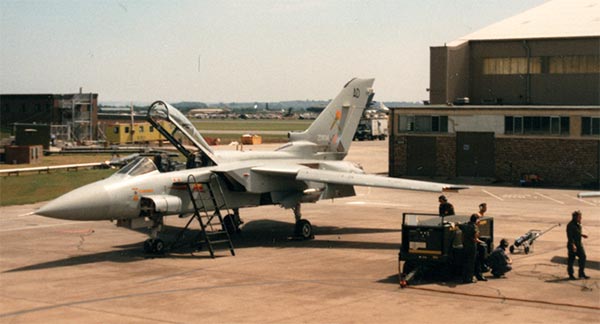
History
The Tornado originated from a UK Staff Requirement in 1969, calling for a medium-range, low-level, counter-air strike aircraft, with the further capabilities of interdiction and reconnaissance. As other European countries had similar needs, it was decided to work together. The Panavia consortium was created, a tri-national consortium which comprised British Aerospace, MBB (later DASA) of Germany and the Italian firm Alenia.
Tornado became a twin-seat, twin-engined, variable geometry aircraft with supersonic capability at all altitudes. Tornado characteristics: high-mounted, variable, swept-back wing for high speed. Two RB199 turbofan engines. The air intakes are diagonal and box-like alongside the fuselage forward of the wing roots. There are twin exhausts. The body thickens midsection and tapers to the tail section. Cockpit for the 2 man crew. The tail is tall, swept-back, and has a tapered fin with a curved tip and a step in the leading edge.
The Tornado IDS is the variant for strike/attack and capable of carrying a wide range of conventional stores, including the JP233 anti-airfield weapon, the ALARM anti-radar missile, and laser-guided bombs. The first IDS version was the GR mk.1 entering RAF service in 1982. The reconnaissance version, designated the GR1A, retains the full operational capability of the GR1. The GR1B, equipped with Sea Eagle air-to-surface missiles, undertakes the anti-surface shipping role. For self-defense, the Tornado IDS may carry 2 Sidewinder air-to-air missiles and it is fitted with twin internal 27mm cannons in the nose. The Gr.mk 4 is a modernized version of the IDS, entering service in 2001. Also an electronic counter (ECR) measures and attack versiion was developed. The ECR carries various ECM and detection systems and is capable of firing air to ground missiles and bombs.
The RAF also needed an Air defense variant (ADV) for long-range interception of Soviet bombers. After a MoD review in 1970 for the RAF, a version of the Tornado was designed for this role, with a dedicated new Marconi/Ferranti AI-24 Foxhunter air-interception radar, housed in an extended radome. Capable of carrying Skyflash radar-guided missiles (which is a derivative of the American Sparrow AIM-7E-2 missile ) and shorter range Sidewinder infra-red homing air-to-air missiles, plus an internally-mounted 27mm Mauser cannon. The IDS's ground-attack systems were removed and the port cannon was deleted.
To improve range,
the ADV has a lengthened fuselage with extra frames behind the cockpit
to accommodate a fuel tank. In order to balance the aircraft and reduce
drag, the wing root gloves got a larger sweep angle and the Kruger flaps
(as fitted on the IDS) were removed. The ADV also received new software
and systems, making it a more "fighter feel" aircraft. But it is not an
agile air superiority fighter like the American F-16 and F-15 Eagle.
The ADV airframe uses components from the Panavia partners with MBB modelling the centre fuselage, Alenia the wings and BAe the front and rear fuselage. Assembly of the ADV was at BAe Warton. The front cockpit is remarkably similar to that of the Strike Tornado IDS variants but lacks the moving map display with a rectangular CRT in place. The rear cockpit also lacks the moving map display but has two CRT screens.
The initial ADV variant was the F.mk.2 of which 3 prototypes were build. First flight was in 1979. The first of 10 production F.mk.2 planes were delivered in 1984 with the original IDS RB199 mk.103 engines and still without a working radar. The radar gave many many problems.
Eight trainer F.mk.2 aircraft were also delivered, and the "twin stick" version has additional rear pilot controls and a non-symmetrical CRT screens layout. In the mid nineties the F.mk.2 aircraft were put out of RAF operational service as the improved F.mk.3 were being delivered.
The F.mk.3 deliveries started in 1988 and the variant received stronger RB.199 mk.104 engines, requiring a rear stretch at the aft fuselage to accommodate the longer jet pipe with afterburner. They could also carry 2 extra Sidewinders on both sides of the wing pylons.
F.mk.3 aircraft later on received a better radar and avionics, although aircraft standards vary. Important was to update the radar and systems to better counter Electronic counter measures and secure communications. Also, some extra outher pylons can be fitted on some aircraft. Later on, chaff/flare dispensers and various other pods could be fitted. The screens in the rear cockpit were modernized with colour LCD screens. Introduction of other types in the RAF also resulted in further weapons standardization. This was started on the Tornado force in 1999 by BAe.
The F3 could now be fitted with Advanced Medium Range Air-to-Air Missiles (AMRAAMs) and Advanced Short-Range Air-to-Air Missiles (ASRAAMs) and has the Joint Tactical Information Distribution System (JTIDS) to work with the Sentry AEW1 airborne early warning aircraft. In 2004 further system enhancements took place.
More than 150 Tornado ADV F.mk.3 were delivered to the RAF, 24 aircraft to Saudia Arabia and 24 aircraft were "leased" by the Italian Air Force as a stopgap (for the F-104S Starfighters) awaiting delivery of their ordered Eurofighters.
RAF Tornado F3 operated from Leeming, Leuchars, Coningsby and a flight in the Falklands. They were replaced by the Eurofighter.
Also check out my Tornado information scrap page...
Let's look at the 1/32 Revell Tornado
kits released (new moulds).
The kit comes in a large box and parts
are finely moulded with engraved panel lines. (NOTE: this kit is not to
be confused with the very old Revell Gr.mk1 and ADV
F2 kits issued in the nineteen eighties).
Overall detail is very good, with nice cockpit with raised details, 10 piece Martin Baker Mk.10 ejection
seats, a radar compartment, refuelling probe and very well detailed stores.
Stores are pylons are all supplied but depend on the particular kit purchased.
Intakes are also well done but no intake ducts although not a lot can be
seen of it. The kit is crampted with details and excellent parts.
The gears are well detailed but vulnerable and must carry considerable weight. The wing can be swivelled, but set them fixed. Improve the seal area aft of the wing. The jet pipes are also very good with good depth and detail. The front fuselage and the rear fuselage joint may need some filler but generally the parts fit well..
What kits and boxes were issued by Revell?
(1) Tornado
IDS kit (German) (Revell kit no 04700):
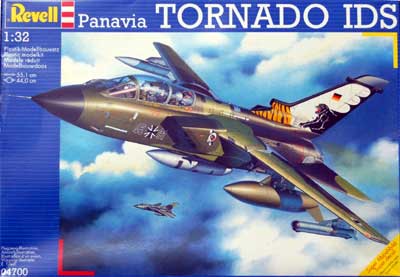
Luftwaffe boxing of the IDS.
Also, the same Revell-Monogram boxing is seen below with parts and decals:
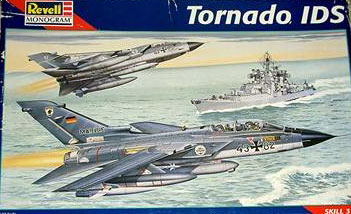 .
.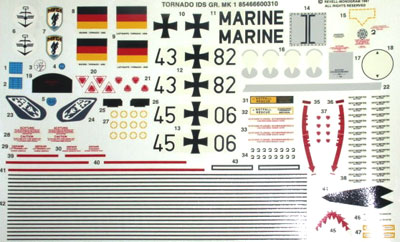
.
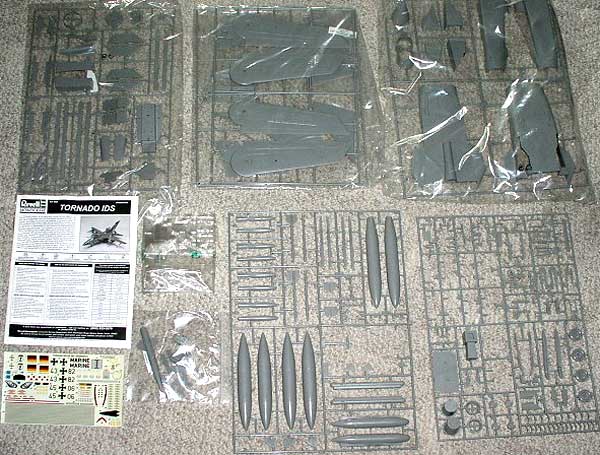 parts
parts

(2) RAF GR.1
(
Revell kit 04705):
The GR.1 kit has the RAF-unique features,
including the laser rangefinder under the nose and air refueling system.
The ejection seats are reasonable MB Mk.10 seats and the landing gear is
nicely done. Stores are two Tornado-standard 1500 liter external fuel tanks,
two Paveway LGBs, two NATO 1000 lb bombs, 2 AIM-9L Sidewinders, one Sky
Shadow and one BOZ self-defense pods, and all the pylons required.
A large sprue has bombs and as extra the large 2250 L Hindenburg tanks. A small sprue has transparant parts with lights etc.
Decals for three RAF aircraft:
No 31 Squadron in an 80 year Anniversary scheme at Bruggen ; No 617
‘Dambusters’ Lossiemouth; MiG eater RAF Tornado Det. at Tabuk in Saudi
Arabia of Desert Storm of 1991. The first two in standard RAF green/grey
and last one in desert ‘pink’.
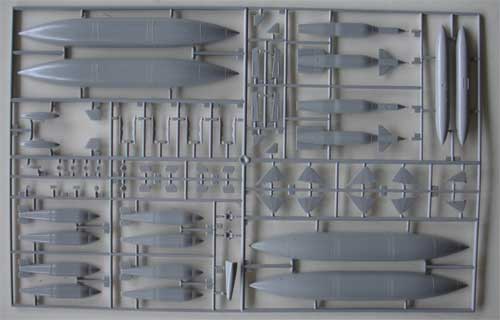
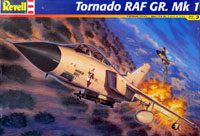
USA
release:
This box is for the Revell/Germany
1/32 Tornado GR.1 kit issued in the USA. It features all of the RAF-unique
features, including the laser rangefinder under the nose and air refueling
system.
The kit is moulded in medium grey
plastic, with the exception of one tree moulded in light grey and, of course,
the clear parts. The kit includes thus two Tornado-standard 1500 liter
external fuel tanks, two 2250 liter Hindenburg tanks and "ground" attack
stores like two Paveway LGBs, two standard NATO 1000 lb bombs, 2 AIM-9L
Sidewinders, one Sky Shadow and one BOZ self-defense pods.
Decals for two Desert Storm RAF aircraft
in "tan colour" .
(3) ECR (Revell
kit 04718)
Revell also released a 1/32 scale
Tornado kit in the Luftwaffe ECR version (Electronic counter measures and
reconnaisance). The kit is essentially the previous Luftwaffe IDS boxing
(not the RAF GR.1 boxing) but with extra parts and new decals for a JaboG
32 Tiger Meet scheme. Extra parts are a pair of HARM missiles, missile
rails, undernose IRLS fairing, undernose FLIR fairing, new instrument panels
for the pilot and backseater, and a new instrument box to go on top of
the rear-seater’s instrument panel.
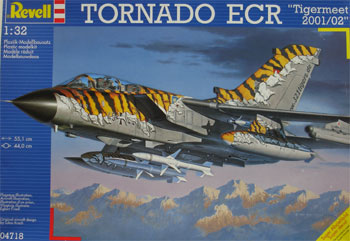
In addition
to these kits, various other aftermarket Tornado
1/32 sets can be purchased from various sources
like:
- Eduard etched
metal Tornado detail set
- Flight Path
sets for flaps, ladders etc
- Paragon set
for flaps
- Various ejection
seat resin sets
- Black Box
/ Avionix cockpit sets
etc. etc
Some of these can be used for an ADV version as well. Decals are to be a combination of various 1/32 decals and possible some home made for squadron markings etc.
Preferably an RAF GR.mk1 kit is the best starting kit for the ADV conversion, but as an ECR kit was readily available at my shop, the main parts were used of this kit. There is however 100% commonality in the main airframe parts in all kits, only details and stores vary. So the conversion should work for all 1/32 Revell Tornado kits (of the new mould).
References:
Books:
- RAF Tornado,
Paul Jackson, Ian Allan publications, Aircraft illustrated special, 1987
- Tornado,
AeroGuide
- Air international,
magazine, Volumes 17/4, 27/3, 29/4 , 34/1, 52/4, 73/6 (December 2007),
AI supplement 2005
- World Air
Power journal, Volumes 31, 32
- Tornado,
Doug Richardson, Aviation fact file, Salamander books, 1986
- Tornado,
Fluzeuge, profile volume 6,
- Tornado,
Ian Black, Airlife, 1990
- Scale aircraft
modelling, August 2003, April 2004, March 2004
- Aerei, “Tutto
Aerei collezione, No. 55, Gennaio 2006 (Italia)
Internet websites:
My Tornado information scrap page here...
Tornado site: http://www.tornado-data.com/
YouTube video: http://www.youtube.com/watch?v=QI-U3-9UO0w
Walk around of my modelling friend Cees Hendriks:
- IPMS NL Tornado walk around
Back to 1/32 Models.......

(c) Copyright Meindert "designer"/ All rights reserved. Your comments are welcomed by webmaster
Created this page:
July 25, 2008